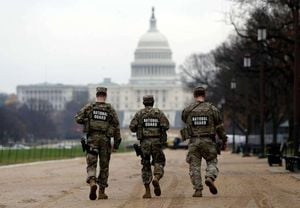Political intrigue, diplomatic maneuvering, and deep divisions in Washington are converging around a contentious new peace plan for Ukraine, as the conflict with Russia drags into its fourth year. Recent developments have exposed sharp rifts not only between the warring parties, but also within the U.S. administration and among its allies, as efforts to broker an end to hostilities reach a fever pitch.
On November 25, 2025, Republican Congressman Don Bacon revealed he had seriously considered resigning over President Donald Trump’s proposed peace plan for the Russia-Ukraine war, according to Axios and the Washington Examiner. The plan, which includes dozens of conditions for both Russia and Ukraine, notably calls for Ukraine’s continued independence but also demands that Kyiv cede some regions currently occupied by Russian forces. Bacon, visibly frustrated, reportedly dubbed the proposal the “Witkoff Ukrainian surrender plan,” a nod to U.S. negotiator Steve Witkoff. Despite his anger, Bacon ultimately decided to stay in office, reasoning, “It wouldn't have been right. When you run for office, you have an obligation to fulfill your term.”
Bacon’s district in Nebraska is fiercely competitive. He narrowly defeated a Democratic challenger last year by just under two percentage points, even as Vice President Kamala Harris carried the district by more than four points. Had Bacon resigned, Nebraska’s governor would have been compelled to call a special election, potentially handing Democrats a golden opportunity to erode the Republicans’ slim six-seat majority in the House. With all but two Republicans needed for party-line votes, even a single vacancy could tilt the balance of power.
House Speaker Mike Johnson, a Louisiana Republican, has tried to project calm. After the 2024 general election, he reassured colleagues, “In unified government, we’re all on the exact same team. This isn’t varsity/junior varsity. This is everybody on the varsity team together, I mean Senate Republicans, House Republicans. And we have to think that way and operate that way, and so you’re gonna see that. You’ll see great cooperation, bicameral cooperation between the two bodies.”
Meanwhile, House Minority Leader Hakeem Jeffries, a New York Democrat, has expressed confidence that Democrats will reclaim the majority in the 2026 midterms, promising to focus on kitchen-table issues like the cost of living, healthcare, and rooting out corruption.
But the drama in Washington is just one part of a much larger story unfolding on the world stage. Hungarian Prime Minister Viktor Orban is expected to meet Russian President Vladimir Putin in Moscow on Friday, November 28, 2025, marking their first face-to-face encounter since July 2024, according to Hungarian outlets Telex and VSquare. Orban, who visited Donald Trump at the White House earlier this month, has positioned himself as a potential intermediary. In October, Hungary was even floated as a possible site for a Trump-Putin summit, though Trump ultimately backed out, citing doubts about any real progress in peace talks.
This week, Trump took to Truth Social to suggest that he could meet both Putin and Ukrainian President Volodymyr Zelensky “soon”—but only after a peace agreement is reached. The prospect of such a high-level summit has added urgency and uncertainty to the already fraught negotiations.
On the ground in Ukraine, the atmosphere is tense and the stakes could not be higher. U.S. Army Secretary Daniel Driscoll is expected to arrive in Kyiv this week to continue negotiations over a possible settlement, according to Andriy Yermak, Zelensky’s chief of staff. Yermak, writing on Telegram, praised Driscoll’s “objectivity and constructiveness,” and stressed that the talks are in line with directives set by President Trump. He highlighted the “urgency of continuing the work necessary to halt the conflict,” and pointed to recent discussions in Geneva as having “laid a solid groundwork.” Zelensky and his team, Yermak said, remain committed to advancing peace efforts.
Yet the path to peace is anything but straightforward. Last week in Kyiv, Driscoll delivered a sobering message to Ukrainian officials. According to sources cited by NBC News, Driscoll warned that Ukrainian troops faced a dire situation on the battlefield and risked imminent defeat as Russian aerial attacks intensified. He bluntly told his counterparts that the U.S. defense industry could no longer sustain the flow of weapons and air defenses needed to protect Ukraine’s infrastructure and population. “The message was basically — you are losing,” one source said, “and you need to accept the deal.”
Driscoll presented a U.S.-backed peace plan that many in Kyiv viewed as a capitulation to Moscow. The original 28-point plan, drafted after discussions in Miami between Russian envoy Kirill Dmitriev and U.S. envoy Steve Witkoff, required Ukraine to cede territory, scale back its military, and abandon any hope of joining NATO. Some elements even appeared to contradict previous U.S. positions, such as language implying that American troops would be barred from Poland. Republican and Democratic senators were told by Secretary of State Marco Rubio that the plan was drafted by the Russians, though Rubio later insisted it was an American proposal with input from both sides.
Ukrainian President Zelensky expressed grave doubts about the plan, but stopped short of rejecting it outright. Instead, he signaled a willingness to continue diplomatic discussions. In the days that followed, Rubio and other officials traveled to Geneva, where, after intense negotiations and pressure from European diplomats, the most problematic provisions were revised or removed. Rubio described the peace plan as a “living, breathing document,” telling reporters, “Every day with input it changes.” By November 25, Ukrainian and U.S. delegations had reached a “common understanding on the core terms of the agreement,” as Rustem Umerov, secretary of Ukraine’s national security and defense council, wrote on social media. The plan had been pared down to 19 points.
President Trump, for his part, has continued to pressure Ukraine. He told reporters that Zelensky’s choice was to accept a peace deal or “continue to fight his little heart out.” On social media, Trump stated that the plan had been “fine-tuned, with additional input from both sides, and there are only a few remaining points of disagreement.” He added, “I look forward to hopefully meeting with President Zelenskyy and President Putin soon, but ONLY when the deal to end this War is FINAL or, in its final stages.”
Behind the scenes, the Trump administration is deeply divided. One camp, led by Vice President JD Vance, special envoy Witkoff, and others, believes Ukraine is the main obstacle to peace and favors using U.S. leverage to force Kyiv into major concessions. Another group, represented by Rubio and others, sees Russia as the aggressor and advocates for continued sanctions and pressure on Moscow. The rift has become increasingly public, with some officials warning that a lasting split could make it “very difficult to pursue a coherent policy,” as former ambassador William Taylor told NBC News.
As the revised plan now more closely resembles previous proposals that Russia has rejected, Russian Foreign Minister Sergey Lavrov has signaled skepticism. He pointed to discussions in August between Trump and Putin in Anchorage, Alaska, suggesting the latest draft may contradict earlier understandings. “Some forces want to jeopardize efforts by Donald Trump and to change the peace plan,” Lavrov said. “If the ‘spirit’ of Anchorage will be wiped out from this plan, then it’s going to be a whole other story.”
With Orban’s visit to Moscow looming, Zelensky’s team still at the table, and the U.S. administration split on strategy, the fate of Ukraine’s future—and the credibility of Western diplomacy—hangs in the balance.





